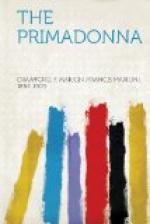Van Torp, who was very strong. With regard to
the late Miss Bamberger the witness thought that Mr.
Van Torp had killed her to get rid of her, because
she was in possession of facts that would ruin him
if they were known and because she had threatened to
reveal them to her father. If she had done so,
Van Torp would have been completely in his partner’s
power. Mr. Bamberger could have made a beggar
of him as the only alternative to penal servitude.
Questioned as to the nature of this information, witness
said that it concerned the explosion, which had been
planned by Van Torp for his own purposes. Either
in a moment of expansion, under the influence of the
drug he was in the habit of taking, or else in real
anxiety for her safety, he had told Miss Bamberger
that the explosion would take place, warning her to
remain in her home, which was situated on the Riverside
Drive, very far from the scene of the disaster.
She had undoubtedly been so horrified that she had
thereupon insisted upon dissolving her engagement
to marry him, and had threatened to inform her father
of the horrible plot. She had never really wished
to marry Van Torp, but had accepted him in deference
to her father’s wishes. He was known to
be devoting himself at that very time to a well-known
primadonna engaged at the Metropolitan Opera, and
Miss Bamberger probably had some suspicion of this.
Witness said the motive seemed sufficient, considering
that the accused had already twice taken human life.
His choice lay between killing her and falling into
the power of his partner. He had injured Mr.
Bamberger, as was well known, and Mr. Bamberger was
a resentful man.
The latter part of Charles Feist’s deposition
was certainly more in the nature of an argument than
of evidence pure and simple, and it might not be admitted
in court; but Isidore Bamberger had instructed his
lawyer, and the Public Prosecutor would say it all,
and more also, and much better; and public opinion
was roused all over the United States against the
Nickel Tyrant, as Van Torp was now called.
In support of the main point there was a short note
to Miss Bamberger in Van Torp’s handwriting,
which had afterwards been found on her dressing-table.
It must have arrived before she had gone out to dinner.
It contained a final and urgent entreaty that she would
not go to the Opera, nor leave the house that evening,
and was signed with Van Torp’s initials only,
but no one who knew his handwriting would be likely
to doubt that the note was genuine.
There were some other scattered pieces of evidence
which fitted the rest very well. Mr. Van Torp
had not been seen at his own house, nor in any club,
nor down town, after he had gone out on Wednesday
afternoon, until the following Friday, when he had
returned to make his final arrangements for sailing
the next morning. Bamberger had employed a first-rate
detective, but only one, to find out all that could
be discovered about Van Torp’s movements.




